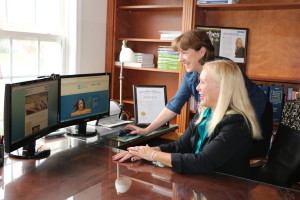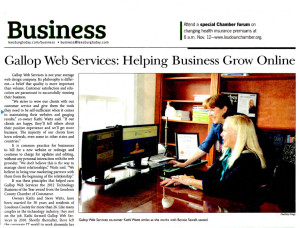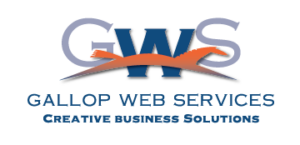The following news article appeared in the Leesburg Today, Loudoun Business News section, on November 7, 2013
Gallop Web Services: Helping Business Grow Online

Kathi Watts of Gallop Web Services works with a client at her office in Leesburg.
Gallop Web Services is not your average web design company. Their philosophy is different—they believe quality is more important than volume. Customer satisfaction and education are paramount to successfully running their business. According to owner Kathi Watts, “We strive to wow our clients with our customer service and give them the tools they need to be self-sufficient when it comes to maintaining their websites and gauging results. If our clients are happy, they’ll tell others about their positive experience and we’ll get more business. The majority of our clients have been referrals, even some in other states and countries.”
It is common practice in this industry to bill for a new website or redesign and continue to charge for updates and ongoing editing, without any personal interaction with the web provider. “We don’t believe this is the way to manage client relationships,” said Watts. “We believe in being true marketing partners with them from the beginning of the relationship.” It was these very principles that led Gallop Web Services to be named Technology Business of the Year by the Loudoun County Chamber of Commerce, a title they hold until the first week of November 2013 when the next award winner will be announced.
The Foundation Behind Gallop Web Services

Gallop Web Services owners Steve & Kathi Watts
Owners Kathi and Steve Watts, have been married for 30 years and residents of Loudoun County for over 26. Like many couples in the technology industry, they met on the job. Kathi formed Gallop Web Services in 2010. Shortly thereafter, Steve left the corporate IT world to come alongside Kathi and take Gallop Web Services to the next level. Over the past three years, they have added to their services a robust search engine optimization package and local business listing offerings. They have enjoyed working together again doing what they both love, right here in Loudoun County.
In the four short years since they have been in the web design business they have seen a wide range of local and regional clients with whom they’ve established an on-going and satisfying business relationship. It is their belief that every client deserves excellent service no matter the size of their online business and what they provide is creative and helpful to the client’s success. The ability for a client to understand and participate in web technology for their business helps to alleviate the feeling of “being held hostage” by an industry where fees and billings are confusing and often not necessary. “Many of our clients think of us as their partners, which we are” said Steve Watts. “We greatly enjoy working closely with them as their expectations evolve and online interactivity continues to emerge as an integral component for businesses everywhere.”
Design and Enhancements for Local Business Mean Real Results
Gallop Web Services has been serving the online business needs of small and large businesses in the region since their inception.
In May 2012, Gallop Web Services worked with Loudoun Medical Group to re-launch their website LMGDoctors.com while also providing hosting and web support services. According to Mary Beth Tamasy, CEO, “Our new site now features an interactive ‘Find a Doctor’ tool, convenient on-line bill pay for patients, a unique mapping tool that allows our customers to quickly see the over 80 physician practice locations, and many other features built in for our staff who access information through a password protected portal.” Gallop said they were thrilled to build an amazing new site for LMG but the proof is also in the numbers. “Their online traffic has seen an overall increase of 41% compared to this time last year. The site has seen a 146% increase in people viewing the individuals physician’s biographies. People are looking into our Loudoun County doctors,” said Kathi Watts.
Gallop Web Services has also worked closely with Bonnie Sewell, Principal of American Capital Planning, a Loudoun County-based financial planning business, on the redesign of her website. Last year, Sewell started a new business entity and wrote a book to educate and financially guide couples who are already in the divorce process. According to Sewell, “Kathi and Steve did designs for both of my sites and I was thrilled with the results.” One of Bonnie’s requests was for Gallop Web Services to create an online calculator for Wedlock-Divorce.com that helps individuals get a better picture of their financial situation as they consider divorce. The addition of this tool on her website gives couples a reality check on how their money might be distributed in a divorce settlement. A glimpse of their financial circumstances has helped steer the conversation between Sewell and her clients.
Online Tips and Tricks to Make Your Site Work for You

Read the Leesburg Today article
According to the website Pingdom, there were 2.4 billion Internet users at the end of 2012 and a staggering 634 million websites. It is imperative that businesses no matter how small or large, put their best foot forward to capture even a small percentage of this amazing potential. According to Kathi and Steve Watts, there are certain things that business owners can and should be doing right now related to their online business marketing. They were happy to provide a short list of essentials for all businesses.
- Mobile Responsive Web Design. If you view your website on an iPad, Smart Phone or other device, does your site respond as well (or better) than it does on a desktop computer? If your site does not readjust to accommodate the current devices used by many on a regular basis, then you may risk the loss of potential customers.
- Online Visibility. Can your customers find you on Google? Type your company’s business name into the search bar on Google. Where does your business land on the list of results? How many relevant sites is your business listed on? By optimizing the search potential for keywords relating to your business, you can increase the marketing potential of your website and social media. The goal is to drive consumer awareness, get leads and make sales.
- Integrate. Link your company website with all your social media interfaces. Facebook, Twitter, LinkedIN are popular examples, but there are many more that may be suited to your type of business. Be sure your social media and website convey the same brand identity. Use a free service, such as Hoot Suite, to combine your social media so you can quickly post and communicate socially through a user-friendly dashboard.
- Blog. It gives you a great medium to share your expertise and keeps your website fresh. A blog also serves as a great partner to all other social media, and adds relevancy with the search engines. It is ideal to have your blog on your website, but there are several stand alone blog services that will do the trick.
- Keep it Fresh. When was the last time you refreshed the photography on your website? What about the content? Do you know how to go about editing the various areas of your website? Simple user-friendly tools available to businesses today make it possible to easily keep your website fresh and current.





